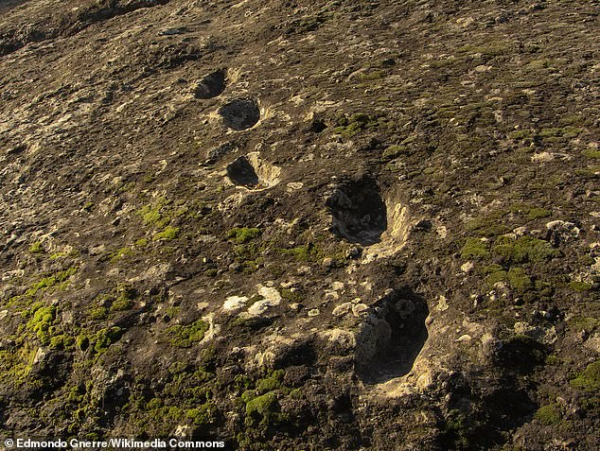Footprints Made by Neanderthals who Walked in Lava Hours After Eruption
Near Roccamonfina in southern Italy lies an extinct volcano which hasn’t been active in millennia. On the side of the volcano are a number of impressions which are clearly footprints.
A few of those prints belong to animals, but most of them are human. Local legend says that the devil once walked down the volcano’s slope, and the tracks are known as the ‘’Devil’s Trail.’
Scientists have measured 67 indentations and scuff marks made by feet and hands. The marks follow three clear tracks down the side of slope.
Recently, 14 more indentations were measured and examined. Those are nearer the bottom of the slope, larger, and at least some of them actually seem to be going back up the volcano.
Geological dating methods have been used on the layers of rock in the area the prints are located in, which established that the prints were made in a soft layer of ash left by the volcano’s eruption some 350,000 years ago.

That makes the Devil’s Trail some of the oldest fossilized human footprints in the world.
It’s difficult for researchers to give conclusive information about the specifics of the people who left the prints, given their extreme age and subsequent weathering.
They do believe, however, that the prints were left by about five different people. There is the possibility that further study could help reveal some general information about them, given time, such as their sexes and how heavy they might have been, at least relatively.
One thing definitely is known, however; whoever left those prints wasn’t a member of our species, since Homo sapiens has only been around for about 315,000 years, 35,000 after the volcano’s eruption.

Michael Marshall writes in the New Scientist that the size and shape of the prints are a match for a species of hominid that predates Homo sapiens and has also been found in Sima de los Huesos in Atapuerca, in the north of Spain.
The remains in Spain are about 430,000 years old, and the exact species they represent has caused some discussion among experts.
Ciampate del Diavolo, sulle orme dei primi italiani: il più antico sentiero preistorico https://t.co/7BDODbTAAd
— la Repubblica (@repubblica) October 16, 2017
They were first believed to be of the species Homo heidelbergensis, then Neanderthals, then Denisovans, and eventually, they were determined again to Neanderthals.
If that assessment is correct, then it would be a good guess that the group who walked the slopes of the volcano at Roccamonfina would have been a group of young adults, although the scientists doing the research aren’t taking that notion for granted.
It’s also anyone’s guess why such a group would have been walking a volcano that had so recently blown its top. The pyroclastic material on the slopes would have started out around 570 degrees Fahrenheit.
The material would have cooled to around 120 degrees by the time those footsteps were made, which is still pretty daunting if your feet are bare.
Even though it still would have been cool enough to walk on, it would still be soft underneath, and the going would have been very slow, perhaps no more than about 3 feet a second.
The area near the foot of the volcano has yielded a number of artifacts during various expeditions to the site.
They’ve largely been made of basalt, a type of black, volcanic rock, suggesting that even though the volcano was at least periodically active, there were a certain number of people who made their homes nearby.
Ciampate del Diavolo, sulle orme dei primi italiani: il più antico sentiero preistorico https://t.co/7BDODbTAAd
— la Repubblica (@repubblica) October 16, 2017
Given that, it’s possible that those prints were made by early humans who already lived in the area and were just interested in seeing what the neighborhood looked like after the eruption.
Incredible Medieval Supertanker Considered the Best Example of its Kind in the World
It would have to take a certain amount of nerve for Neanderthals to build a life near an active volcano in the first place, so perhaps it’s not too surprising that afterwards they would want to come survey the damage and try to figure what it meant for their lives.





